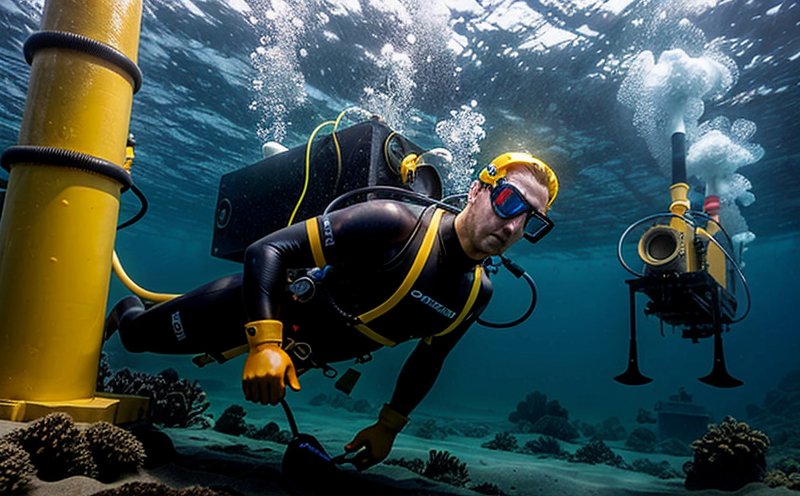ISO 17636 Radiographic Testing of Subsea Welds
The ISO 17636 radiographic testing standard is a cornerstone in ensuring the reliability and integrity of subsea welds. This stringent testing procedure guarantees that every weld adheres to the highest quality standards, thereby enhancing the safety and performance of marine equipment.
Subsea welding is an essential process for constructing deep-sea structures such as oil rigs, pipelines, and other critical infrastructure underwater. The harsh conditions and extreme pressures of subsea environments demand rigorous inspection methods to ensure weld integrity. ISO 17636 provides a standardized approach that ensures consistent testing results regardless of the location or manufacturer.
The process involves using radiographic imaging techniques such as X-rays or gamma rays to detect internal defects in the welds. This non-destructive method allows for precise assessment without compromising the structural integrity of the equipment being tested. The key steps in this procedure include:
- Preparation of the test specimen, ensuring it is clean and free from contaminants
- Application of appropriate radiographic materials
- Exposure to the specified radiation source for a defined period
- Capture of images using film or digital detectors
- Development and evaluation of the radiographs by qualified personnel
The acceptance criteria outlined in ISO 17636 are stringent, focusing on the absence of defects within critical areas of the weld. This ensures that any potential issues are identified early on, allowing for corrective actions to be taken before deployment.
In addition to ensuring compliance with international standards, this testing method also plays a crucial role in maintaining regulatory requirements and insurance policies. By adhering to ISO 17636, operators can demonstrate their commitment to safety and quality, thereby fostering trust among stakeholders.
The benefits of adhering to ISO 17636 extend beyond compliance; it enhances the overall reliability and longevity of subsea equipment. Regular testing not only prevents costly repairs but also minimizes downtime, leading to significant operational savings in the long run.
Why Choose This Test
Selecting ISO 17636 radiographic testing for your subsea welds offers several compelling reasons:
Enhanced Safety: Ensures that all welds meet the highest quality standards, reducing the risk of failure under extreme conditions.
Compliance with International Standards: Adheres to ISO 17636, ensuring your operations comply with global best practices and regulatory requirements.
Increased Efficiency: By identifying defects early in the testing process, you can avoid costly rework and delays.
Improved Reputation: Demonstrating adherence to stringent quality standards can enhance your company's reputation within the industry.
The thoroughness of this testing method ensures that only reliable welds are used in critical applications. This commitment to excellence is crucial for maintaining safety and operational integrity, especially in environments where failures could have severe consequences.
For quality managers and compliance officers, ISO 17636 provides a clear framework for ensuring consistent and reliable results. R&D engineers can leverage this method to innovate while adhering to strict standards. For procurement professionals, selecting suppliers who adhere to these standards ensures the highest quality materials and components are used.
By choosing ISO 17636 radiographic testing, you invest in a future of reliability and safety for your subsea equipment. This commitment not only meets current regulatory requirements but also prepares you for future challenges in the industry.
Quality and Reliability Assurance
The process of ISO 17636 radiographic testing is designed to provide comprehensive quality assurance through a series of stringent steps. These include:
Thorough preparation of the test specimen, ensuring it is clean and free from contaminants.
Application of appropriate radiographic materials tailored to the specific requirements of subsea welds.
Exposure to a radiation source for a specified duration, ensuring adequate penetration into the weld structure.
Capture and evaluation of high-quality images using advanced digital detectors or film techniques.
The acceptance criteria are based on international standards such as ISO 17636, which outline specific limits for acceptable defects. Any welds that do not meet these criteria must undergo additional scrutiny until they comply with the specified requirements.
By adhering to these rigorous procedures, we ensure that every subsea weld is subjected to the highest level of scrutiny. This commitment to quality and reliability is a testament to our dedication to excellence in marine equipment testing.
The process is not just about compliance; it's about ensuring that each weld meets or exceeds the expectations set by industry leaders. Our team of experts ensures that every step of the ISO 17636 radiographic testing procedure is meticulously followed, providing peace of mind and confidence in the integrity of your equipment.
Competitive Advantage and Market Impact
The adoption of ISO 17636 radiographic testing for subsea welds offers substantial competitive advantages. Here’s how it impacts your business:
Increase in Client Trust: Demonstrating adherence to stringent international standards builds trust with clients, partners, and stakeholders.
Enhanced Reputation: A reputation for quality and reliability enhances your brand image within the industry.
Reduced Risk of Failures: By ensuring weld integrity through rigorous testing, you minimize the risk of failures that could lead to downtime or accidents.
Potential for Innovation: Compliance with ISO standards allows you to innovate while maintaining a high level of quality and safety.
Market demand for reliable subsea equipment is growing as industries push boundaries in deep-sea exploration and infrastructure development. By investing in ISO 17636 radiographic testing, you position your company at the forefront of this market evolution.
The implementation of these standards ensures that every aspect of the weld is thoroughly examined, leading to a higher level of confidence in the equipment’s performance under extreme conditions. This commitment to excellence not only meets current regulatory requirements but also prepares you for future challenges and opportunities.





